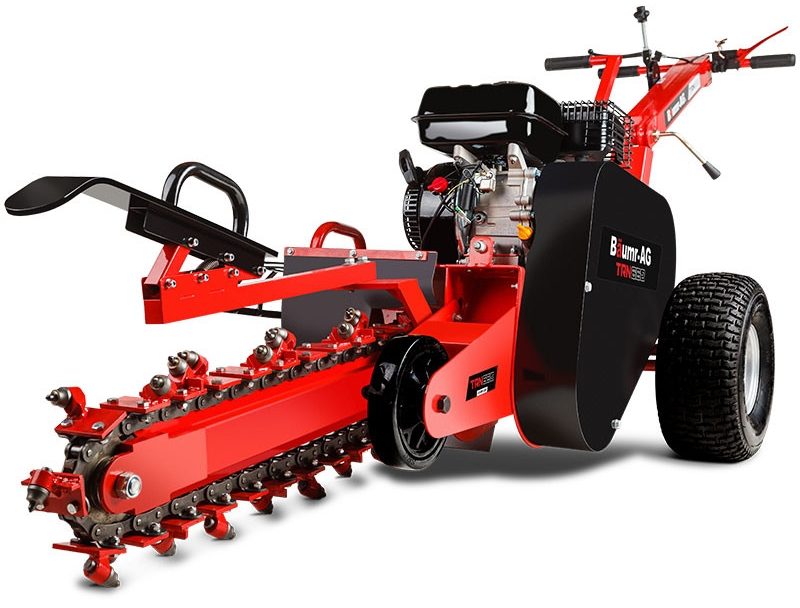Trencher Digger is Chain Driven – Discover the Difference
Ever found yourself looking at a tangled patch of roots, rock-hard clay, or fire break lines and thought, “There’s got to be an easier way to dig this trench”? Whether you’re prepping your backyard for new irrigation, running cables on a rural block, or you’re on the fireground carving a control line, the right gear can make all the difference. For many Aussies—families, tradies, renters, even the local brigade—a chain-driven trencher digger is fast becoming the secret weapon. But what does “chain driven” actually mean, and how does it stack up against other digging gear?
This guide will break it all down: how chain-driven trenchers work, why they matter for both everyday jobs and fire response, and the biggest traps to avoid (from busted cables to wasted weekends). You’ll find real stories, calm advice, and tips for every living situation—from city gardens to bush properties and fire crews. We’ll cover setup, safe use, teamwork, recovery, and long-term planning. Let’s take the mystery (and a bit of the sweat) out of trenching.
If you’re after a rugged, reliable chain-driven unit that gets the job done, check out this high-performance Baumr-AG Chain-Driven Trencher Digger—perfect for serious digging at home or in the field. We’ll explain how to use one safely and get the best results, no matter your experience.
What Does “Chain Driven” Really Mean?
“Chain driven” might sound a bit technical, but the concept is simple: Instead of wheels, blades, or single digging teeth, a chain-driven trencher uses a powerful rotating chain with sharp teeth—think of it like a giant, heavy-duty chainsaw, but built for dirt instead of wood.
The chain moves continuously around a long boom, digging into the ground as it rotates. As it cuts through soil, roots, and even small rocks, it creates a neat, consistent trench at the depth and width you set. Some units can go up to half a metre deep or more, depending on the model.
You’ll often see these on building sites, farms, and—especially during bushfire season—on the backs of trailers headed out to rural communities or fire lines. They’re popular for installing pipes, cabling, irrigation, drainage, and, in fire management, cutting emergency breaks or access lines through scrub.
How to Prepare: Getting Ready for a Trenching Job
At Home or on the Farm
- Map out your trench line first—mark any known pipes, cables, or garden beds
- Check with your local council or “Dial Before You Dig” for hidden utilities
- Clear surface debris and trim overhanging plants
- Have a plan for where the excavated soil will go—keep it out of walkways
- Review safety steps, especially if kids or pets are nearby
On the Fireground
- Brief the team: clarify task, chain depth, hazards, and escape routes
- Check fire radios and comms—assign a spotter if possible
- Inspect the chain drive for tension and wear before starting
- Ensure water or extinguishers are close by for hot, dry work areas
- Share the job—trenching is hard yakka, don’t let fatigue set in
Why Choose a Chain-Driven Trencher Digger?
- Power and Consistency: Cuts through compacted soils, roots, even some loose rock—much more efficiently than hand digging or smaller tillers
- Cleaner, Safer Trenches: A uniform cut helps with laying pipes, cables, or forming control lines—less risk of gaps or uneven depths
- Time Saver: What might take hours with a shovel can be finished in minutes
- Versatility: Suitable for all sorts of jobs—gardens, farms, remote fire breaks, new builds, or emergency access
- Durability: Chain-driven models are designed for heavy workloads and tough conditions—less breakdowns, more uptime
How to Use a Chain-Driven Trencher: Step-by-Step
- Read the Manual: Even if you’ve dug trenches before, every unit is different. Pay attention to safety shutdowns, depth settings, and chain maintenance tips.
- Inspect Before Use: Check chain tension, teeth wear, fuel or power supply, and all safety guards.
- Set the Depth: Adjust for your job. For backyard irrigation, shallow is fine. For fire breaks or pipes, you may need the max depth—always check for hazards below.
- Start and Warm Up: Allow the engine to settle and check all controls—never rush the first few minutes.
- Begin Trenching: Lower the chain slowly into the ground with a firm grip. Guide the machine forward—never force it. If it hits a rock or root, stop and check for damage.
- Monitor Progress: Regularly pause to clear excess soil and check the trench for straightness and depth. Hydrate and switch operators if needed.
- Finish and Shut Down: Raise the boom before turning off. Let the engine idle to cool. Clean the chain and boom to avoid rust.
Common Mistakes When Using Chain-Driven Trenchers
- Not checking for underground utilities—easy way to cut power or water lines. Always check first.
- Pushing the machine too fast—let the chain do the work or you risk jamming or damaging teeth.
- Ignoring chain wear—dull or loose chains will slow you down and create uneven trenches.
- Overheating the motor—especially in summer or on firegrounds, rest the machine regularly.
- Not wearing PPE—eye and ear protection, gloves, and boots are a must. Dust and debris can fly up quickly.
- Leaving soil piles in pathways or fire breaks—keep access clear for people, vehicles, and hoses.
- Working solo—where possible, always have a spotter or buddy, especially on remote or fire-prone blocks.
Real Stories: From Backyards to the Fire Line
At Home: A young couple on a rental property wanted to add an irrigation line for their veggie patch. They rented a chain-driven trencher for the weekend. After mapping their run, checking with “Dial Before You Dig,” and setting the correct depth, they finished the trench in just two hours—instead of two days by hand. “The trick,” they said, “was letting the chain do the digging, not rushing.”
On the Fireground: During a bad fire season, one brigade used a chain-driven trencher to cut a rapid mineral earth break around a vulnerable property. The chain bit through tough clay and roots where shovels failed. Their key lesson: Regular chain checks and team rotations made the job safer and kept fatigue at bay. Having extra fuel on hand and a clear escape plan also mattered.
For Community Teams: One rural warden shared, “We once skipped the chain inspection and lost half an hour to a jammed tooth. Now, we always check before every run. It’s saved us time—and a few headaches.”
Extra Tips for Safe and Easy Trenching
Renters & Families
- Check with your landlord before trenching on rental properties
- Flag the area for safety—curious kids or pets can get hurt
- Clean up soil and debris as you go to avoid mess or falls
Older Aussies & People with Disabilities
- Ask for help—many councils offer volunteer support or community services
- Choose lighter models, or hire a pro if unsure
- Use ramps or boards for stable movement over steps or curbs
Fire Crews & Rural Teams
- Plan rest breaks and swap operators to prevent heat stress
- Bring spare chains, fuel, and basic tools for field repairs
- Keep water/first aid kits close—trenching kicks up dust and debris
Planning Ahead: Maintenance and Long-Term Use
- After every job, wash off dirt and grit—chains rust fast if left dirty
- Check chain teeth for dullness, chips, or bending—replace as needed
- Store the trencher somewhere dry and covered, away from kids or pets
- Keep a record of fuel use, chain changes, and any repairs (a simple notebook or phone note works)
- Before fire season, test run the machine and check for any issues—don’t wait until it’s urgent
For more on safe storage and tool maintenance, see our guide: Home Maintenance Checklist (Seasonal)
Recovery: Wrapping Up Safely and Next Steps
Trenching jobs aren’t finished until the gear is cleaned, checked, and put away. On the fireground, make sure all crews sign off and report any issues. At home, let the soil settle before filling in the trench or laying pipes—this prevents future dips and trips.
Remember, a well-maintained chain-driven trencher will serve you for years, saving time and effort, whether you’re prepping a garden or helping keep your community safe during emergencies.
Further Reading & Related Guides
- Best Petrol Handheld Cultivator Tiller for Your Garden
- Mulcher Chipper Price & Review | Michigan 15HP 420CC
- Home Maintenance Checklist (Seasonal)
Frequently Asked Questions
Yes, chain-driven trenchers are designed for tough ground, including clay and some rocky soils. Just go slow, inspect the chain regularly, and clear out large rocks by hand first where possible. Always wear PPE—flying debris is no joke.
Absolutely, as long as you check with your landlord and stick to marked boundaries. Smaller models are available for tight spaces. Just be sure to map utilities, keep kids and pets away, and clean up when you’re done.
Rinse off grit after every job, check for dull teeth, and oil moving parts before storage. Replace the chain or teeth as needed. For heavy use, keep a spare chain on hand—it’ll save you headaches in the long run.
A chain trencher digs long, narrow trenches—perfect for pipes, cables, or fire breaks. A rotary tiller is for breaking up and mixing soil, not for deep or narrow cuts. If your job needs a clean, straight line, go for the chain-driven trencher.
Plan your route before starting, watch for hidden hazards, and rotate operators to manage fatigue. Always have water and first aid handy. Report any damage or issues straight away—field repairs save lives and time.
Reuse it for garden beds or fill low spots where possible. For large jobs, arrange a skip bin or check council rules. Keep soil piles off paths and fire access tracks at all times.
Ready to take on your own trenching job—at home, at work, or as part of your local crew? Take five minutes to review your safety steps and plan your first dig. And if you found this guide helpful, share it with your neighbours, mates, or team!
This article was created using practical emergency preparedness and firefighting advice and reviewed for clarity. It is intended as general public information for Australian households, communities, and emergency service teams.



